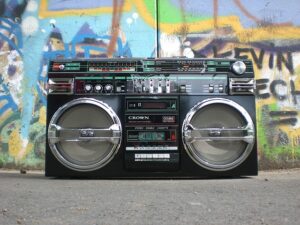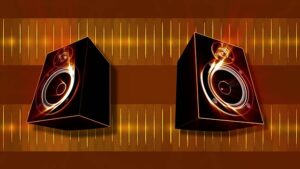Electrical energy is a versatile form of energy that can be converted into various other forms, including sound energy. Sound energy is the energy produced when an object vibrates, creating sound waves that travel through a medium, such as air or water. This conversion from electrical energy to sound energy is made possible through the use of devices such as speakers and headphones. By understanding how electrical energy is transformed into sound energy, we can appreciate the technology behind audio devices and the role they play in our daily lives. In this article, we will explore some examples of how electrical energy is converted into sound energy, and delve into the science behind this fascinating process. So, let’s dive in and discover the wonders of electrical energy transforming into sound energy!
Key Takeaways
- Electrical energy can be converted into sound energy through the use of transducers.
- Transducers, such as speakers or buzzers, convert electrical signals into mechanical vibrations that produce sound waves.
- The conversion of electrical energy to sound energy is commonly used in various applications, including audio systems, telecommunication devices, and alarm systems.
- Understanding the process of converting electrical energy to sound energy is essential for designing and troubleshooting sound-producing devices.
Examples of Electrical Energy Converted to Sound Energy
Loudspeakers
Loudspeakers are a common example of electrical energy being converted into sound energy. They play a crucial role in audio systems, such as home theaters, music players, and public address systems. Let’s explore how electrical energy is converted into sound energy in loudspeakers.
In a loudspeaker, electrical energy is received through an electrical circuit. The electrical signals are then sent to a voice coil, which is a wire coil wrapped around a cylindrical former. When an electrical current passes through the voice coil, it creates a magnetic field. This magnetic field interacts with a permanent magnet, causing the voice coil to move back and forth rapidly.
The movement of the voice coil is transmitted to a diaphragm, which is a thin, flexible cone-shaped membrane. As the voice coil moves, it pushes and pulls the diaphragm, causing it to vibrate. These vibrations create sound waves in the surrounding air, which we perceive as sound.
Electric Bells in Schools and Colleges

Another example of electrical energy being converted into sound energy is electric bells used in schools and colleges. These bells are commonly used to signal the start and end of classes or other important events. Let’s take a closer look at how electrical energy is converted into sound energy in electric bells.
Electric bells consist of a metal bell and a clapper. When an electrical current flows through the bell, it creates a magnetic field. This magnetic field attracts the clapper, which is a piece of metal with a small weight at one end. The clapper is held away from the bell by a spring.
When the electrical current is switched on, the magnetic field pulls the clapper towards the bell, causing it to strike the bell. This impact produces a sound wave, which we hear as a ringing sound. When the electrical current is switched off, the magnetic field disappears, and the spring pulls the clapper away from the bell, stopping the sound.
Earphones
Earphones, also known as headphones, are widely used for personal audio listening. They convert electrical energy into sound energy, allowing us to enjoy music, podcasts, and other audio content. Let’s delve into how electrical energy is converted into sound energy in earphones.
In earphones, electrical signals from an audio source, such as a smartphone or music player, are transmitted through a wire to a small speaker unit. The speaker unit consists of a moving diaphragm, which is a thin membrane made of a flexible material like plastic or metal.
When the electrical signals reach the speaker unit, they cause the diaphragm to vibrate. These vibrations create sound waves that travel through the air and into our ears, enabling us to hear the audio. The quality of the sound produced by earphones depends on factors such as the design of the diaphragm, the size of the speaker unit, and the overall construction of the earphones.
Cordless Headphones
Cordless headphones, also known as wireless headphones, are becoming increasingly popular due to their convenience and freedom of movement. These headphones also convert electrical energy into sound energy, allowing us to listen to audio without being tethered to a device. Let’s explore how electrical energy is converted into sound energy in cordless headphones.
Cordless headphones use batteries to store electrical charges. These batteries provide the necessary electrical energy for sound generation. When audio signals are transmitted wirelessly from a device, such as a smartphone or computer, they are received by the headphones.
Inside the headphones, the electrical signals are converted into sound waves using a similar mechanism as earphones. The electrical signals cause a moving diaphragm to vibrate, producing sound waves that we can hear. The use of batteries in cordless headphones allows for portable and wireless sound reproduction.
Television

Television sets are essential devices in our homes, providing both visual and auditory entertainment. They convert electrical energy into both light and sound energy, allowing us to enjoy our favorite shows, movies, and sports events. Let’s explore how electrical energy is converted into sound energy in televisions.
In televisions, electrical energy is used to generate sound through the vibration of electrical energy across coils. The electrical signals representing the audio content are sent to a speaker system within the television. The speaker system consists of a diaphragm, similar to the one used in loudspeakers and earphones.
When the electrical signals reach the speaker system, they cause the diaphragm to vibrate rapidly. These vibrations generate sound waves that travel through the air and into our ears, allowing us to hear the audio accompanying the visuals on the television screen. The quality of the sound produced by televisions depends on factors such as the design of the speaker system and the overall audio capabilities of the television.
Mixer
Mixers are commonly used in music production and live sound setups to control and blend audio signals. They also convert electrical energy into sound energy, allowing for the manipulation and amplification of audio. Let’s explore how electrical energy is converted into sound energy in mixers.
In mixers, electrical energy is used to power the rotation of blades or knobs. These blades or knobs are responsible for controlling various audio parameters, such as volume, equalization, and effects. When electrical energy is supplied to the mixer, it powers the rotation of these components.
As the blades or knobs rotate, they manipulate the electrical signals representing the audio content. These manipulations result in changes to the sound, such as adjusting the volume or applying equalization. The sound produced by mixers is then sent to other audio devices, such as amplifiers and speakers, for further amplification and reproduction.
Refrigerators
Refrigerators are essential appliances in our homes, keeping our food fresh and preserving perishable items. While primarily known for their cooling capabilities, refrigerators also generate sound due to the flow of electrical energy. Let’s explore how electrical energy is converted into sound energy in refrigerators.
In refrigerators, electrical energy is used to power various components, such as compressors, fans, and motors. These components work together to maintain the desired temperature inside the refrigerator. As electrical energy flows through these components, it can generate vibrations and mechanical movements.
These vibrations and mechanical movements can produce sound waves that we hear as a humming or buzzing noise. The generation of sound in refrigerators is primarily attributed to the thermal expansion and contraction of materials as the temperature inside the refrigerator changes. The sound produced by refrigerators is generally considered normal operation and is not indicative of any malfunction.
Electric Doorbells
Electric doorbells are commonly used in homes and buildings to signal the arrival of visitors. They convert electrical energy into sound energy, allowing us to hear when someone is at the door. Let’s explore how electrical energy is converted into sound energy in electric doorbells.
Electric doorbells consist of a button, a chime, and an electrical circuit. When the button is pressed, it completes the electrical circuit, allowing electrical energy to flow. This electrical energy powers a mechanism that produces mechanical energy, which in turn generates sound.
The mechanism typically involves the use of an electromagnet and a striker. When the electrical circuit is closed, the electromagnet becomes magnetized, attracting the striker towards it. The striker hits the chime, producing a sound wave that we hear as the doorbell ring. Once the button is released, the electrical circuit is broken, and the sound stops.
In conclusion, there are various examples of electrical energy being converted into sound energy in everyday devices. From loudspeakers and earphones to electric bells and refrigerators, these devices rely on the conversion of electrical energy to produce sound waves that we can hear. Understanding the mechanisms behind these conversions helps us appreciate the role of electrical energy in sound production and enhances our overall audio experience.
Radio System

A radio system is a device that converts electrical energy into sound energy, allowing us to listen to our favorite music, news, and other audio content. It relies on the conversion of electrical energy to sound energy to produce the desired audio output. Let’s explore how this conversion takes place and how radio systems work.
Conversion of Electrical Energy to Sound Energy in Radio Systems
In a radio system, electrical energy is converted into sound energy through a series of processes. It all starts with the generation of electrical signals, which carry the audio information. These signals are then amplified and modulated onto a carrier wave, which is a high-frequency electromagnetic wave.
The modulated carrier wave is then transmitted through the air as radio waves. When these radio waves reach a receiver, such as a radio antenna, they are captured and converted back into electrical signals. These electrical signals are then processed and amplified to drive a speaker, which converts the electrical energy into sound energy.
Tuning of Electrical Signals to Vibrate the Diaphragm for Sound Production
To produce sound in a radio system, the electrical signals need to be tuned and amplified in a way that they can vibrate a diaphragm. The diaphragm is a thin, flexible membrane located inside the speaker. When the electrical signals pass through the speaker, they cause the diaphragm to vibrate back and forth rapidly.
As the diaphragm vibrates, it pushes and pulls the surrounding air molecules, creating compressions and rarefactions. These compressions and rarefactions travel through the air as sound waves, eventually reaching our ears. Our ears detect these sound waves and convert them into electrical signals that our brain interprets as sound.
Electric Guitar

The electric guitar is another example of how electrical energy can be converted into sound energy. Unlike acoustic guitars, electric guitars rely on electrical circuits and pickups to generate sound from the strings.
Conversion of Electrical Energy to Sound Energy in Electric Guitars
In an electric guitar, the strings are made of metal and are not responsible for producing sound directly. Instead, when the strings are plucked or strummed, they create vibrations. These vibrations are then picked up by electromagnetic pickups, which are essentially coils of wire wrapped around magnets.
When the strings vibrate, they disturb the magnetic field around the pickups, inducing an electrical current in the coils. This electrical current is then sent to an amplifier, where it is amplified and converted into sound energy through a speaker.
Conversion of Electrical Energy to Sound Energy During Lightning
Lightning is a natural phenomenon that also involves the conversion of electrical energy into sound energy. When a lightning bolt occurs, it heats up the surrounding air to extremely high temperatures. This rapid heating causes the air to expand explosively, creating shock waves that travel through the atmosphere.
The shock waves generated by lightning are responsible for the booming sound we hear as thunder. The sound energy is produced by the rapid compression and expansion of air molecules, which creates the characteristic rumble or crackling noise associated with thunderstorms.
In conclusion, electrical energy can be converted into sound energy in various ways, ranging from radio systems and electric guitars to natural phenomena like lightning. Understanding these processes helps us appreciate the intricate relationship between electricity and sound, and how they can be harnessed for our enjoyment and understanding of the world around us.
Conclusion
In conclusion, the conversion of electrical energy to sound energy is a fascinating process that plays a crucial role in various aspects of our daily lives. By understanding the principles behind this conversion, we can appreciate the technology and devices that allow us to enjoy the sounds around us. From speakers and headphones to musical instruments and communication systems, the transformation of electrical energy into sound energy enables us to experience and communicate in a rich and vibrant auditory world. Whether it’s the melodic tunes of our favorite songs or the clear and crisp voices during a phone call, electrical energy to sound energy conversion is an essential part of our modern society. As technology continues to advance, we can expect even more innovative ways to harness and utilize this conversion process for our benefit. So, the next time you listen to your favorite song or engage in a conversation, take a moment to appreciate the remarkable journey from electrical energy to sound energy that makes it all possible.
Frequently Asked Questions
1. What is electrical energy?
Electrical energy refers to the energy carried by electric charges. It is the energy associated with the movement of electrons through a conductor, such as a wire.
2. How is electrical energy converted to sound energy?
Electrical energy can be converted to sound energy through the use of electrical devices such as speakers or headphones. These devices convert electrical signals into sound waves, producing sound energy.
3. Can you provide an example of electrical energy converted to light, sound, and thermal energy?
Certainly! An example of electrical energy converted to light, sound, and thermal energy is a light bulb. When electricity flows through the bulb, it produces light energy, sound energy (in the form of a faint humming sound), and thermal energy (as the bulb heats up).
4. What are some examples of electrical energy converted to sound energy?

Examples of electrical energy converted to sound energy include speakers, musical instruments (such as electric guitars or keyboards), and sirens. These devices use electrical energy to generate sound waves and produce audible sound.
5. Can you provide an example of electrical energy converted to mechanical, wind, and sound energy?
Certainly! An example of electrical energy converted to mechanical, wind, and sound energy is an electric fan. When electricity powers the fan, it converts electrical energy into mechanical energy to rotate the blades, which in turn creates wind energy. The movement of air then produces sound energy.
6. How does energy transfer occur in electrical to sound conversion?
Energy transfer in electrical to sound conversion occurs through the process of energy conversion. Electrical energy is converted into sound energy by electrical circuits or devices, where the electrical signals are transformed into sound waves.
7. How is sound production related to electrical energy?
Sound production is related to electrical energy through the process of energy conversion. Electrical energy is used to generate electrical signals, which are then transformed into sound waves, resulting in sound production.
8. What role do electrical circuits play in sound generation?
Electrical circuits play a crucial role in sound generation. They provide the pathway for electrical energy to flow and are responsible for converting electrical signals into sound waves, enabling the production of sound.
9. How does energy conversion occur in electrical to sound conversion?
Energy conversion in electrical to sound conversion involves the transformation of electrical energy into sound energy. This conversion takes place within electrical devices or circuits, where electrical signals are converted into sound waves, resulting in the generation of sound.
10. How is acoustic energy related to electrical energy?
Acoustic energy is related to electrical energy through the process of energy conversion. Electrical energy is converted into acoustic energy when electrical signals are transformed into sound waves, allowing for the transmission of sound energy.
Also Read:
- How to calculate energy and frequency
- How to measure sound energy dissipation in concert hall acoustics
- How to improve electrical energy efficiency in smart home systems
- How to calculate elastic energy in archery bows
- Gravitational energy examples
- How to determine energy in adaptive optics
- How to find delta h in gibbs free energy
- How to improve elastic energy efficiency in bungee cords for safety
- Example of electrical energy to kinetic energy
- How to determine the chemical energy conversion rate in a fuel cell
I am Keerthi K Murthy, I have completed post graduation in Physics, with the specialization in the field of solid state physics. I have always consider physics as a fundamental subject which is connected to our daily life. Being a science student I enjoy exploring new things in physics. As a writer my goal is to reach the readers with the simplified manner through my articles.